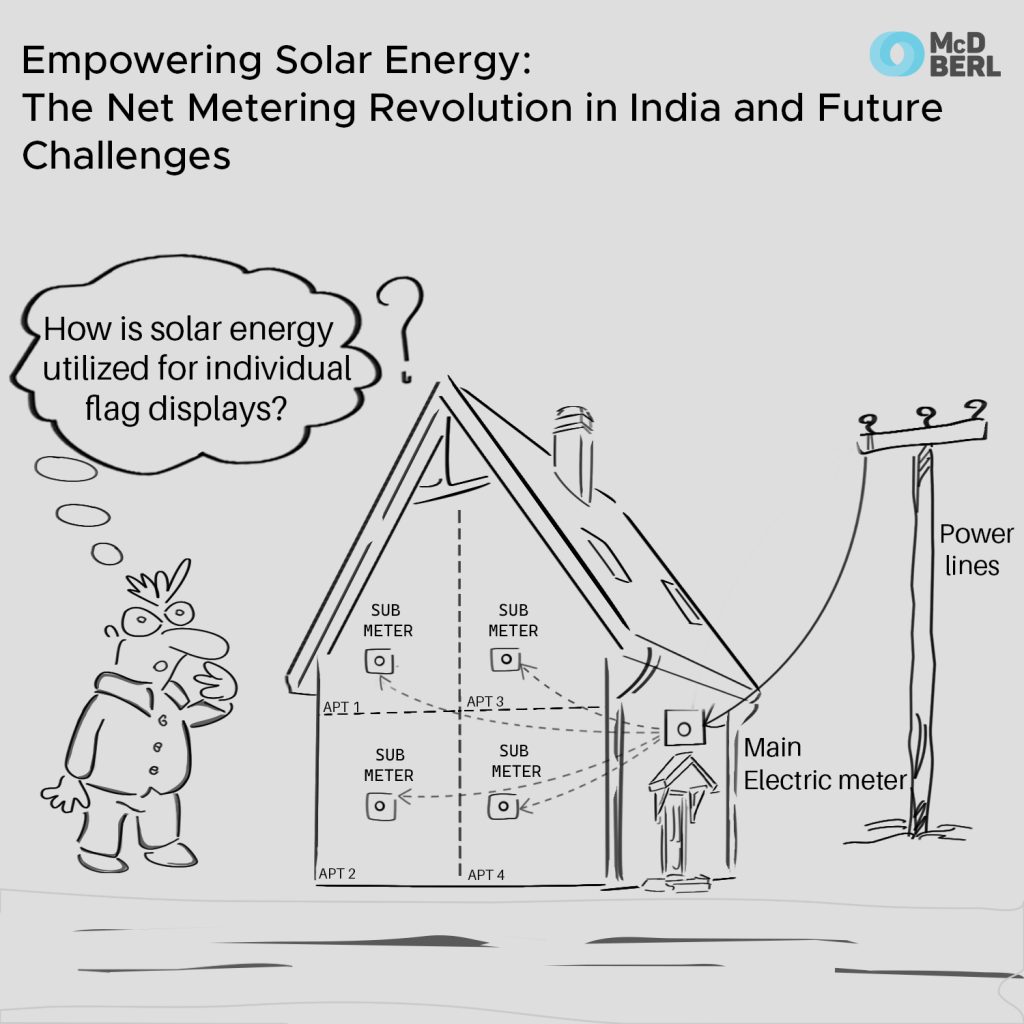Empowering Solar Energy: The Net Metering Revolution in India and Future Challenges

What Is Net Metering?
Net energy metering (NEM), system is a metering and billing mechanism designed to monitor and record the flow of power between a solar energy system and the government grid. Solar meters are an important aspect in the design of privately-owned grid-tied solar energy systems.
The net metering solar arrangement allows you to send unused surplus power to the grid instead of letting it get wasted. Also, it proves to be an economical alternative to an off-grid solar system framework where expensive solar batteries are used as a means of energy storage.
The net metering concept is highly rewarding for residential solar owners who receive energy credit for transferring excess solar electricity to the grid. Homeowners can use these credits to purchase electricity when their energy demand exceeds what the panels can provide.
How Does a Net Metering Solar System Work?
A solar power system is tied to a utility grid via a solar meter and the main service panel or circuit. When the solar panels generate more power than required at the site, the power meter directs the unused solar energy to the grid. At this point, the meter is reversed from its usual direction. Thus, a bidirectional meter for solar is required to facilitate the net metering arrangement.
Bi-directional means the meter works in both directions (export and import of power). It measures the units of grid electricity purchased (when on-site power demand exceeds the on-site solar energy output). A bidirectional solar energy meter also measures the transfer of surplus electricity to the grid. In the latter case, your electric meter runs backwards, even to the point of offsetting your grid withdrawals.
Method of Billing
The customer settles the “net” of inflow and outflow transactions. If your grid exports are higher in a month, you may see a notably lower, even negligible, electric bill.
For example:
Rate of electricity exported to the grid during the day: Rs. 100
Rate for electricity imported from the grid at night: Rs. 120
Net bill for the day: Rs. 20
With a net metering solar system, you receive a credit to your bill for every unit of solar electricity transferred to the grid. When your solar generation is reduced or zero, you can pay for your grid withdrawals using the banked solar credits. You can count on your bidirectional electric meter to maintain an accurate record of this energy exchange every month.
It’s important to note that each state’s net metering regulations differ. Consumers are advised to reach out to the local DISCOM company for complete details. These include the net metering application process, the tariff rates for exports and imports, and the type of net meter to be installed.
The Benefit of Net Metering System
The net metering policy increases the monetary advantages of solar energy. An electric meter for solar panels eliminates the need to buy expensive solar batteries for power storage. This makes solar energy systems more affordable, promoting sustainable energy use among residential and commercial consumers. Net metering is beneficial for both consumers and power companies in many ways, such as:
- Cost-Saving for Consumers: Net metering enables solar energy system owners to produce excess electricity during daylight hours, thereby reducing their dependence on the grid and lowering their electricity bills. These cost savings can be invested somewhere else.
- Grid Optimisation: Net metering assists in balancing grid demand by lowering peak load demand throughout the day, resulting in fewer instances of load reduction. It also helps reduce technical and commercial transportation losses for state Distribution Companies (DISCOMS).
- Eliminate Battery Costs: With the grid functioning as a vast energy depository, costly battery storage systems are unnecessary. This reduces the cost of solar installations, as only a tiny battery backup is needed for power outages.
- Minimal Maintenance: Solar panels and inverters utilized in net metering systems have only a few moving elements, resulting in low maintenance requirements. Panels typically include lengthy warranties, and the absence of moving parts lowers the likelihood of failure.
- Environmental Benefits: By decreasing the demand for electricity from conventional sources, net metering contributes to a sustainable planet. It aids in the reduction of greenhouse gas emissions and promotes environmental preservation by promoting clean, renewable energy sources.
While rooftop solar adoption is increasing in India, net metering implementation faces significant challenges. The intermittent nature of solar power generation leads to significant voltage fluctuations that often exceed established limits. These fluctuations can place a strain on the power transmission system and even compromise its security. In addition, the presence of non-linear components in solar systems creates electrical disturbances, which interfere with equipment, telephone circuits, and metering accuracy. Transferring undesired DC into an AC-driven grid may lead to power loss and transformer overheating.
To realize the maximum potential of net metering in India, these obstacles must be resolved. This requires implementing stringent voltage regulation, assuring compliance with harmonics standards, and taking precautions against unintended islanding. Managing reverse power transfer in grids with a high penetration of photovoltaics is also crucial.
Conclusion
Net metering is a promising way to harness solar energy in India, per the country’s renewable energy objectives. While substantial progress has been made in the regulatory framework, challenges like voltage fluctuations, electrical disturbances, and inconsistent policies continue to remain. Addressing these challenges, along with optimizing interconnection processes and ensuring uniform policy interpretation, will be crucial to unlock the full potential of solar net metering in India.




